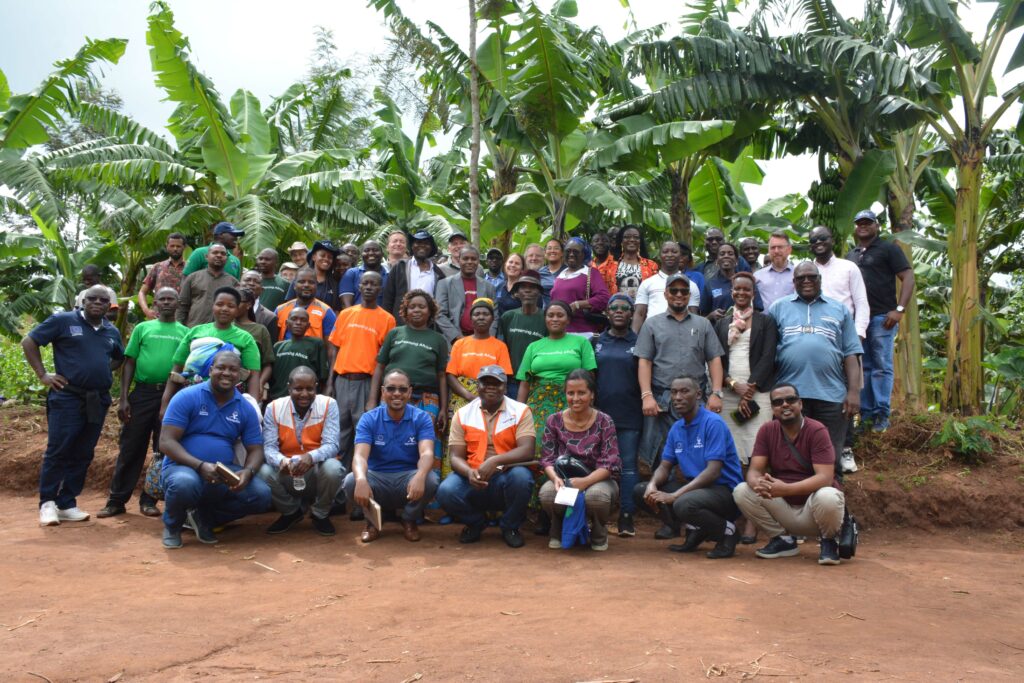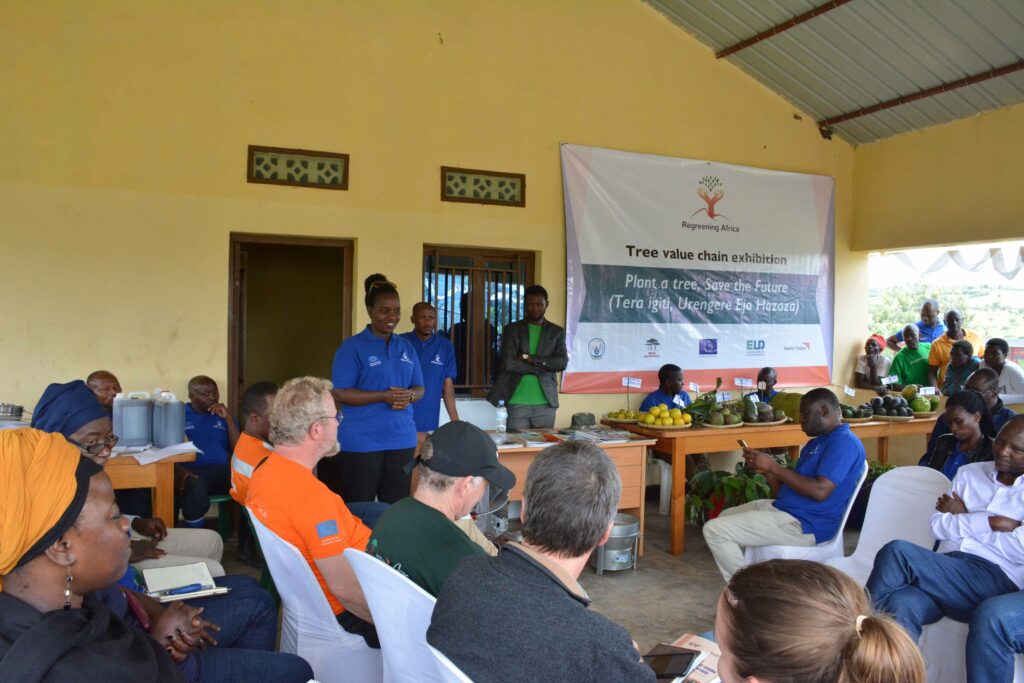By Marion Aluoch
After a phenomenally successful five-year run, the key stakeholders and implementers of the Regreening Africa programme gathered in Rwanda for the project’s reflection and way forward. The five-day Regreening Africa end of project workshop ran from 29th November to 3rd December 2022. The first two days of the workshop were devoted to visiting farming communities to discuss restoration practices and implementation and to provide implementing organisations with opportunities to compare restoration efforts.
 The Regreening Africa Programme team in Rwanda for the close out workshop. Photo: Regreening Africa/Marion Aluoch
The Regreening Africa Programme team in Rwanda for the close out workshop. Photo: Regreening Africa/Marion Aluoch
The first field visit was to Gahurura cell in the Rukomo Sector of Nyagatare District. The purpose of the visit was to observe how the farmers had incorporated trees into their crop production. The tree nurseries in the region were set up and run by cooperatives. This was a requirement by World Vision to ensure high seed production and quality seedling.
Annually, the cooperatives produce up to 70,000 seedlings, with Grevillea robusta being the most popular tree species in the region due to its tolerance and resistance to termites. Grevillea robusta was planted along farm boundaries for demarcation, as a windbreak, and to prevent soil erosion. The leaves of the trees when they fall to the ground, were used as fertiliser, while the tree’s dry branches are used by households as firewood.
Increased maize yields represented an immediate benefit of the agroforestry efforts. As the Nyagatare District is situated in a predominantly hilly region of Rwanda, it frequently experiences strong winds. These strong winds would initially breakdown the maize stalks. Since the trees began acting as wind breaks, this has ceased, resulting in increased maize yields. Both the collection and sale of firewood from Grevillea branches and the sale of fruits have substantially increased household income.
Local and national government policies regarding land use and livestock management were extremely beneficial to the programme. Important among these policies was the 50/50 ownership of land between spouses in a household. This allowed women to actively participate in the management and restoration of their land. Similarly, government mandated cattle enclosures and zero grazing prevented animal intrusion on farms and made manure collection easier.
In terms of seedling variety and quality, the region still lagged behind. The nurseries had very minimal fruit trees. Securing high-quality seeds of indigenous and exotic trees locally was a difficult task. At the time of the visit, through capacity building, the farmers had mastered seedling production through nurseries and grafting as well as crop management techniques. It was determined that moving forward, there was a need to increase sensitisation in order to include farmers from other regions.
The engagement of farmers was also a successful strategy used. The farmers were motivated to participate through dialogue and adequate training, not coercion. This method of engagement and training allowed the farmers to take up the restoration practices. The farmers taking ownership of the project was also a crucial final step in ensuring the project’s sustainability after the close of the project.
The second field visit was to Nyagashanga Cell, Karangazi Sector in Nyagatare District. This was a Rural Resource Centre (RRC) built on land donated by the Rwandan government and managed by the cooperatives. The government also provided a subsidy covering 50% of construction costs while the cooperative and the project contributed the remaining 50%. The RRC was established to empower farmers on water harvesting, tree planting and cultivation, beekeeping and the sale of tree seedlings.
 Lead farmers in Rwanda display their products at the Rural Resource Centre in Nyagashanga Cell. Photo: Regreening Africa/Patrick Worms
Lead farmers in Rwanda display their products at the Rural Resource Centre in Nyagashanga Cell. Photo: Regreening Africa/Patrick Worms
Regreening Africa supported in the construction and establishment of the RRC. This was accomplished by utilising existing social capital to expand the project’s reach. World Vision Rwanda had previously carried out a programme in the region, allowing Regreening Africa to build upon those networks. In addition, the project made us of locally sourced construction materials (bricks, briquettes) which fostered community buy-in of the project. World Vision Rwanda and Regreening Africa, fully appreciating the importance of stakeholder engagement, immediately engaged and involved the local leadership in the project.
The project has not been without challenges. Acquisition of indigenous seedlings and maintenance of high seed quality proved challenging. The rural community’s reliance on firewood as its primary fuel source also proved problematic. World Vision Rwanda has been distributing energy-efficient cooking stoves that use less firewood as an incentive to encourage tree planting.
 Interactions between the community, farmers, and Regreening Africa team at the rural resource centre. Photo: Regreening Africa/Marion Aluoch
Interactions between the community, farmers, and Regreening Africa team at the rural resource centre. Photo: Regreening Africa/Marion Aluoch
Regreening Africa is finalising its first phase, but the interventions will still continue. To sustain the project at its present standards, the cooperatives intends to reach out to more members who are not yet involved in restoration. Similarly, World Vision Rwanda always lets the administrations at the local level to lead on the project implementation to ensure project continuity. World Vision Rwanda also collaborates closely with cooperatives to provide internships at the Rural Resource Centre.
This story was produced with the financial support of the European Union. Its contents are the sole responsibility of Regreening Africa and do not necessarily reflect the views of the European Union.

